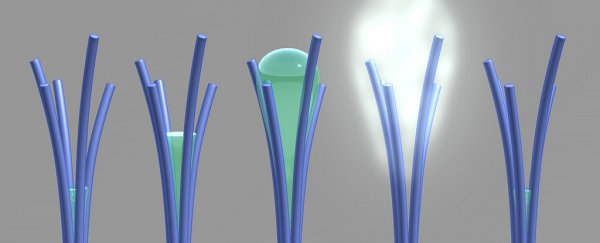Incredible scientific discoveries happen all the time when researchers haven't been looking for them, and new nanorods that harvest water from the air are no exception.
These unintentionally produced carbon-rich microscopic stalks absorb and release water differently to every other material we know about. They can absorb more water at low humidities, then expel it as the humidity increases to 50-80 percent - other materials simply carry on taking in the extra liquid in the air.
As Gizmag's Michael Irving points out, these nanorods could eventually be used in a range of applications, from low-energy water-harvesting systems to perhaps fabrics that can remove excess sweat from the body.
"Our unusual material behaves a bit like a sponge; it wrings itself out halfway before it's fully saturated with water," explained one of the material's creators, David Lao from the Pacific Northwest National Laboratory (PNNL).
Here's how the happy accident came about: the team was trying to create magnetic nanowires in the lab, but ended up producing these carbon nanorods instead. Upon closer inspection, the nanorods appeared to lose weight as the humidity of their environment increased.
At first, the scientists though their equipment was malfunctioning.
It turns out that this phenomenon had first been considered back in the 1990s. The team dug up previous papers from 2012 and 2013 that referenced those hypotheses and showed how water can spontaneously vaporise if it's confined in an area less than 1.5 nanometres wide - or when it's tightly surrounded by hydrophobic (water-repelling) materials.
What seems to be happening, says the team, is that water is condensing and forming a bridge between the nanorods through a process called capillary condensation. The water between the rods causes surface tension that pulls adjacent rods closer together, and when the gap gets to 1.5 nanometres, the water evaporates.
The PNNL team goes so far as to call it a potential "paradigm shift in water purification and separation", suggesting sheets of these nanorods could one day even harvest water from desert air perhaps. Right now only 10-20 percent of the material spits out water, and the researchers are looking to see if they can increase that.
"Now that we've gotten over the initial shock of this unforeseen behaviour, we're imagining the many ways it could be harnessed to improve the quality of our lives," said one of the team, engineer David Heldebrant. "But before we can put these nanorods to good use, we need to be able to control and perfect their size and shape."
The findings have been published in Nature Nanotechnology.
